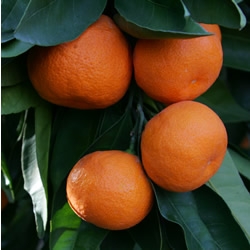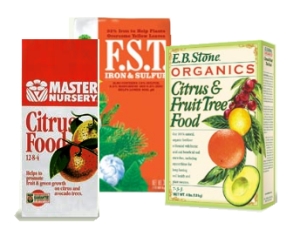The Citrus Care Guide
Light & Watering Requirements

Citrus like to be planted in a sunny location. We recommend an area with at least 6 hours of sun, preferably in the afternoon.
Citrus also like regular watering. They like moist, but not soggy soil conditions or locations with standing water. For young trees, water about 2 to 3 times a week during the hot summer months, giving your trees about 5 gallons of water a week. More mature trees (those that have been planted for 3 years or more) should be watered about every 7 - 14 days depending on the weather. During the winter months, the trees only need to be watered during periods when no rain has fallen for a couple of weeks. Citrus grown in containers will need more frequent watering, especially during the hot summer months.
Remember: Timely, regular watering is essential for proper growth and fruiting of citrus.
Fertilizing Recommendations

Citrus like to be fertilized for best
growth and fruit production. Feed your citrus with a specially formulated
Citrus Food like the Master Nursery Citrus Food or EB Stone Citrus
& Fruit Tree Food once in the Spring, once in the early Summer, and
once in the early Fall. Your citrus food should contain the following
micro-nutrients for best results: calcium, iron, sulfur, manganese, and zinc.
Beginning in November, begin feeding your Citrus with Master Bloom
or EB Stone Ultra Bloom (0-10-10) to promote root development and blooms
for the spring. Also, use an iron supplement, like Greenall F.S.T. to
help strengthen your citrus and increase the juiciness and size of the fruit
for the following season. Apply these products once a month until
February.
Note: Be sure not to give your Citrus high nitrogen too
late in the fall. This can increase the chance of frost damage. It promotes new
growth which is tender at the wrong time.
Pruning Guidelines
The best time to prune citrus is in the Spring after last frost, though pruning can be done in the Summer and Fall. Most of the time, pruning is for shaping and . When pruning, remove excessive growth or damage caused by frost in addition to any dead branches found in the center areas of your citrus.
Common Problems
Fruit Drop:
Some fruit drop is normal. Usually during the first high temperatures in late Spring or early Summer a large portion of the immature fruit will fall. This is the trees way of naturally thinning itself. However, if you have continued fruit drop or fruit is dropping during other times, you may need to provide more regular watering.
Common Insects Problems:
Some of the more common insects that tend to bother citrus are aphids, scales, and mites. Often time these insects are brought to the trees by ants. So, if you see a trail of ants going up your citrus, there are probably aphids or scales in your tree as well. Another indication of these insects is a sticky residue on the leaves. Most of the insects will be found on the back side of the leaves. Scales may be found along the branches as well and will look like bumps along the limbs. Scale can be white, black, or brown. These insects are seen most often in the Spring and Fall, but can be a problem at any time of the year. For control of these insects, you can use Master Nursery Horticultural Oil, Monterey Take Down Garden Spray, or Eight.
Yellowing Leaves
Yellow leaves can be a result of
several things. It could be a result of lack of fertilizer and minerals, a
watering problem, or insect damage. When diagnosing a problem, take into
account how often you water, when and how often you fertilize, and when the
last time you inspected your tree for insects. If the older leaves are turning
yellow and the other leaves are a pale green, then you may need to add
nitrogen. If the leaves are yellowing, but the veins on the leaves are green,
then your citrus most likely needs iron. If the outer leaves are yellowing and
some of the branches are dying back, the citrus may be getting too much water.
Inspect the soil to see how moist the soil is. Leaves that are being damaged by
insects will also turn yellow. Inspect the leaves, especially the backside of
the leaves to look for insects. Mites are hard to detect and look like small
dots on the backside of the leaves.